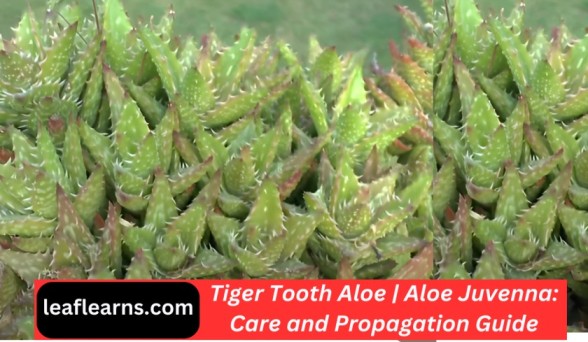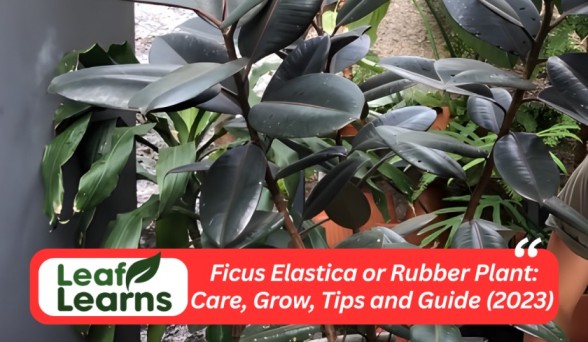Calathea White Fusion Care, Propagation, Tips & Guide (2023)
The Calathea White Fusion, scientifically called Calathea lietzei, is a plant type is herbaceous perennial plant and its belonging to the Marantaceae family. This plant having green leaves. It can reaching heights of up to 2 feet (60 cm), this plant compitate in temperatures ranging from 65 to 75°F (18-24°C) and its can placed in high humidity conditions, where growing levels above 50% is necesasry. The calathea white fusion scientific name is Calathea lietzei.
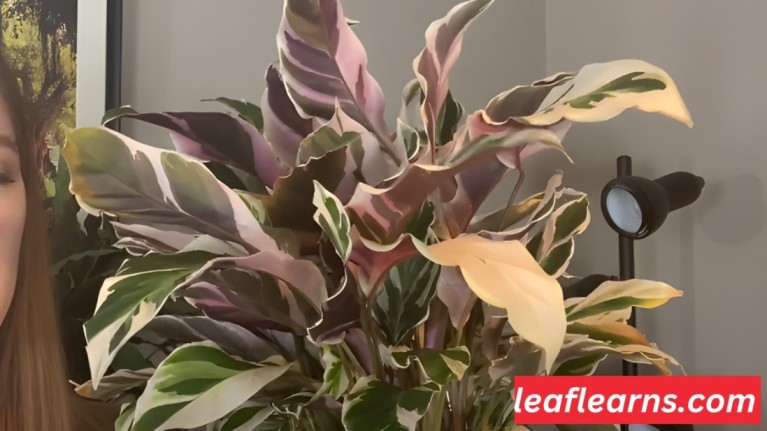
To maintain its shape and protect from the dust particle, regular pruning is recommended to trim any brown or damaged leaves.
When it put into the lighting, the Calathea White Fusion thrives in bright, indirect light but this plant should protect from direct sunlight. Ensure that the soil remain completely moist but not waterlogged is essential for its well-being, and its lightly acidic soil pH is good for perfect growing.
It can produce the flowers in different colours like yellow, purple, or white. This plant beware of potential pests like mealybugs and spider mites that could distract from its clean appearance.
| Common name | Calathea White-Fusion |
| Scientific Name | Calathea lietzei |
| Family | Marantaceae |
| Distribution | Cultivated hybrid (exact origin may vary) |
| Plant type | Herbaceous Perennial |
| Size | Up to 2 feet (60 cm) in height |
| Leaf Colour | Green with white and pink streaks |
| Leaf size | 6-12 inches (15-30 cm) in length |
| Temperature | 65-75°F (18-24°C) |
| Humidity | High humidity preferred (above 50%) |
| Pruning | Trim brown or damaged leaves as needed. |
| Light requirement | Bright, indirect light (no direct sun) |
| Soil requirement | Moist, Well-drained |
| Watering Need | Keep soil consistently moist but not soggy |
| Soil pH | Acidic |
| Flower colour | Yellow, purple, white |
| Pests | mealybugs, spider mites |

Contents
- 1 Top Care Tips
- 2 Calathea White Fusion Care
- 3 Pruning
- 4 Growth Rate and Size
- 5 Calathea White Fusion Propagation
- 6 How to Grow From Seed
- 7 Repotting
- 8 Flowering and foliage
- 9 Overwintering
- 10 Common Pests
- 11 Plant Diseases
- 12 How to Get Calathea White-Fusion to Bloom
- 13 Plants Problems and Solutions
- 14 Toxicity of Calathea White Fusion
- 15 white fusion plant Appearance
- 16 Suggested Uses
- 17 Calathea White Fusion Australia: A Guide to Thriving Foliage
- 18 Mastering Calathea White Fusion: Tips for Successful Cultivation and Propagation
- 19 Conclusion
- 20 FAQs
Top Care Tips
- Keep It Moist, Not Soaked:
- Regularly water your Calathea White-Fusion, but don’t overwater it.
- Make sure the soil is wet but not drenched in the top inch.
- To avoid waterlogging, choose a pot with holes for drainage.
- Filtered Indirect Light:
- Put your plant in a spot with bright, filtered light.
- Avoid the sun’s direct rays since they might burn the foliage.
- Working well is a window with a curtain filter or a few feet away from a window.
- Maintain Humidity:
- Calathea-White Fusion enjoys moisture. At least 50% humidity is desirable.
- Use a humidifier, a humidity tray, or often spritz the leaves.
- Keep it away from heating vents and droughts.
- Regularly Dust and Clean:
- To eliminate dust, gently wipe the leaves with a moist cloth.
- Leaves that are free of dust absorb light and air more effectively.
- As a result, your plant continues to look alive and healthy.
- Fertilize Wisely:
- Feed a balanced liquid fertilizer to your white fusion plant.
- Every 4-6 weeks during the growth season (spring and summer), apply.
- When growth slows in the autumn and winter, cut back on or stop fertilizing.
Calathea White Fusion Care
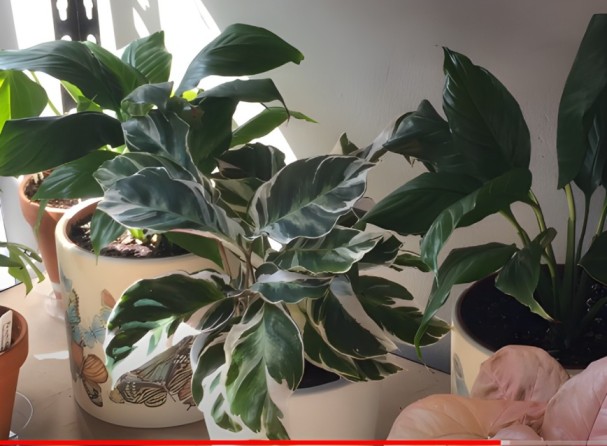
Light requirement
Giving your plant the proper amount of light is essential for its maintenance. This plant loves to be next to a window but protected from direct sunlight since it appreciates bright, indirect light.
Think of it as receiving filtered, mild sunshine, similar to sitting in the shade on a hot day. It can burn if placed in intense, direct sunlight, which is bad for its gorgeous white and green foliage.
Your Calathea WhiteFusion will be content and healthy if you can only find the ideal cosy position in your house with soft, indirect light.
Water Requirements
Pay close attention to your Calathea White-Fusion’s water requirements if you want to take excellent care of it. The soil should be regularly damp, but not soggy, for this plant. It’s similar to striking a balance between a moist and a wet sponge.
When the top inch of soil seems just a little bit dry to the touch, you should water it. Always use a pot with drainage holes to stop water from pooling there, as this can cause root rot.
Keep an eye on the soil’s moisture content and alter your watering plan as necessary to avoid overwatering.
Soil Requirement
It’s essential to pay attention to the soil requirements of your this plant in order to properly care for it. This plant prefers a soil mixture that drains well and has a mild acidity. Imagine it as an excellent sponge that can hold moisture but doesn’t remain wet.
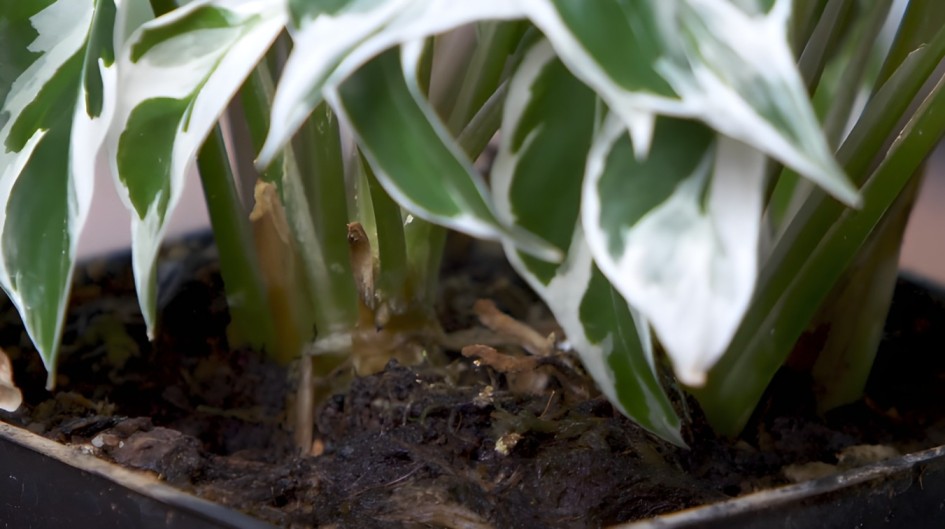
It works best to combine potting soil, perlite, and some peat moss or coco coir. In addition to allowing water to percolate through the soil and avoid root rot, this combination maintains enough moisture levels to keep your plant healthy. To allow extra water to drain, make sure the pot includes drainage holes.
The secret to maintaining the health of your Calathea-White Fusion is to routinely check the soil moisture and alter your watering schedule accordingly.
Temperature Requirement
When it comes to temperature, Calathea White-Fusion has a little bit of a Goldilocks attitude it likes everything to be just perfect.
It prefers a warm and stable atmosphere, ideally between 65 and 75 degrees Fahrenheit (18 and 24 degrees Celsius).
Avoid subjecting it to sharp temperature changes or draughts since these things might make it irritable. It will repay you with gorgeous foliage if you see it as seeking a comfortable, secure home.
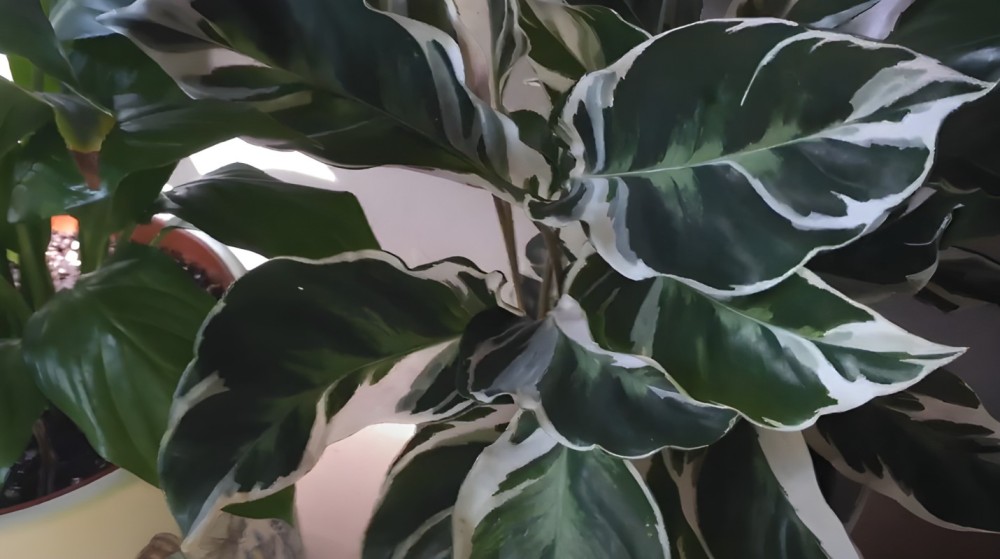
Humidity Requirement
For Calathea White-Fusion to be content and healthy, she needs a lot of humidity. Consider it giving your plant a tropical spa day! This means that you should strive to maintain the air surrounding it as wet as possible, aiming for a minimum humidity of 50%.
You may use a room humidifier or put a tray of water next to your plant to do this. Another approach is to intermittently lightly sprinkle its leaves with water. Just picture spraying a mini-rainforest shower of cool air on your plant.
Keep it away from heating vents and dry draughts since it enjoys a warm, humid environment. Your White Fusion will flourish and display lovely leaves with the correct humidity.
Fertilization Requirement
Giving your Calathea White-Fusion some fertilizer is like giving it a little energy. Imagine it as a plant vitamin Your plant will benefit from some plant food during the spring and summer growth seasons.

Feed your Calathea every four to six weeks with a balanced liquid fertilizer (you can purchase this at a garden supply store).
It’s like giving your plant a tasty snack! However, you may cut back on the snacks and lessen or even stop fertilising in the autumn and winter when it’s not growing as rapidly.
Potting Requirement
It’s crucial to pick the appropriate container and soil when potting your Calathea White plant. Because this plant dislikes sitting in water, use a container with drainage holes to prevent water from collecting at the bottom. Use a potting mix that drains well, is airy, and can hold some moisture.
It works well to combine perlite or orchid bark with peat-based soil. Every one to two years, repot your plant to give it new soil and a little bigger container as it develops.
This keeps the soil in good condition and offers the plant space to grow. Remember that good potting is essential to the continued happiness and health of your White Fusion.
Pruning
Keeping your Calathea-White Fusion tidy and healthy is the main goal of pruning. You should use clean, sharp scissors or pruning shears to remove any yellowing or damaged leaves at their base.
This maintains the plant looking neat and allows it to focus its energy on future development. Additionally, you can cut the higher stems to promote a bushier appearance if your Calathea starts to seem too lanky or unruly. Do not overprune; a small amount of trimming here and there will suffice to keep your White Fusion in great condition.
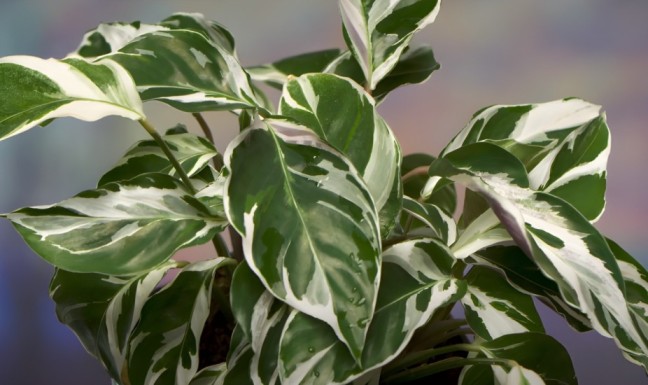
Growth Rate and Size
When grown as a houseplant, the Calathea fusion white grows slowly and normally achieves dimensions of 1 to 2 feet in height and breadth. It doesn’t grow very quickly, but with the right care, it can gradually get bigger.
The primary draw of this plant are its leaves, which often reach a length of 6 to 12 inches. It will grow more leaves as it ages, giving it a bushier look.
Although the growth rate might vary based on conditions like light, humidity, and temperature.
Calathea White Fusion Propagation
You can propagate Calathea through dividing it. Here are the different ways you can propagate this beautiful plant:
- Division
- The most frequent and effective way to spread Calathea plant is by division.
- Hold off until the plant has reached its full size, which is often in the spring or early summer.
- Make sure each area of the root ball has healthy roots and leaves before gently removing the plant from its container.
- Replant the separated parts in other pots with new potting soil.
- Stem Cuttings
- Calathea White-Fusion may also be propagated via stem cuttings, albeit this method is less often than division.
- Cut a stem with numerous healthy leaves right below the leaf node, which is where the leaf joins the stem.
- Put the cutting in a container with wet potting soil or immediately into a water-filled jar.
- Once the cutting has developed roots, keep it in a warm, humid area before transplanting it into a separate pot.
- Leaf Cuttings
- Calathea-White Fusion may be propagated through leaf cuttings, however this method is less dependable than others.
- Chop up a healthy leaf into parts, each of which has a segment of the main vein.
- Lay these pieces out horizontally on the potting mix-filled surface of a container.
- To produce the appearance of a little greenhouse, cover the cuttings in plastic wrap or a plastic bag.
- Transplanting roots and young shoots into separate pots occurs once they have developed.
- Air Layering
- Although air layering is a more complex propagation technique. It can work only for this plant.
- Make a tiny cut in a healthy stem or pare away a piece of the outer bark.
- To the exposed part, apply rooting hormone.
- Cover the injured area with plastic wrap after wrapping it in wet sphagnum moss.
- Cut the stem below the moss after roots have formed, then plant it in a fresh container.
- Rhizome Division
- If the rhizome of your white fusion plant has grown thick, you can divide it into portions to propagate the plant.
- Make certain that every segment has sound roots and at least one leaf.
- Replant the separated parts in other pots with new potting soil.
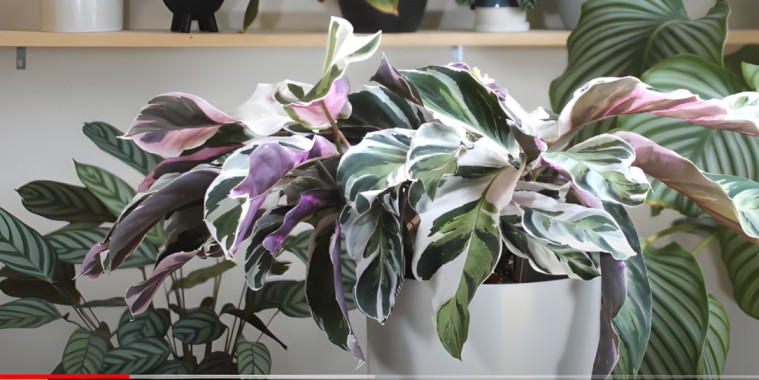
How to Grow From Seed
Since they frequently don’t generate seeds inside, growing this plant from seeds might be difficult. Instead, cuttings or division are usually used for propagation.
However, if you’re fortunate enough to get seeds, plant them in a potting mix that drains well, keep the humidity high, and keep them in indirect light. Be patient since germination might take some time. When seedlings become adult plants, care for them according to standard Calathea care instructions.
Repotting
Repotting is necessary for the health of your plant. It’s time when it outgrows its container or gets root-bound. Select a pot with drainage holes that is somewhat bigger.
Remove the plant with care, separate the roots, and set it in the new container with new potting soil. Watch it grow as you water it!
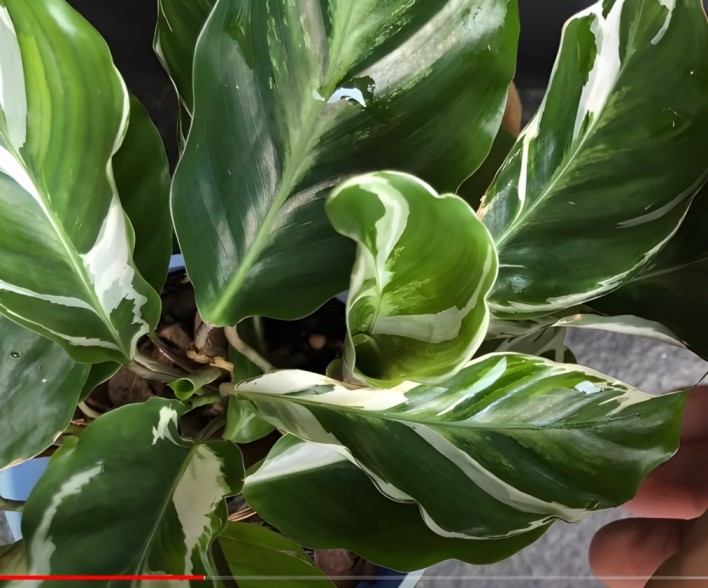
Flowering and foliage
The foliage of Calathea White-Fusion is recognised for its stunning patterns of pink, white, and green that resemble delicate brushstrokes. The major draw of this plant, which attracts leaf lovers, are its attractive leaves.
Although its blossoms are less well-known than its magnificent leaves, you may still observe tiny, discreet white flowers when it blooms.
The reason why most people cultivate this plant is for its vibrant, rich leaves. It may flourish inside with the right care, bringing a sense of tranquilly and natural beauty to your living area.
Overwintering
Giving your Plant a winter break entails overwintering it. Because it grows more slowly in the cooler months, reduce watering a little.
In order to maintain a constant interior environment, shield it from draughts and chilly temperatures. It may be kept healthy till spring by trimming any broken leaves and keeping it warm.
Common Pests
Mealybugs, spider mites, and aphids are typical pests that might annoy your Calathea White Fusion. By draining out its fluids or weaving webs, these microscopic invaders can harm your plant.
Watch for any indications of pests such as white cottony patches (mealybugs), fine webbing (spider mites), or little insects (aphids). Neem oil or insecticidal soap may be applied right away to treat them, keeping your plant healthy and pest-free.
Plant Diseases
Calathea-White Fusion plant diseases may be troublesome, but prevention is the key. Keep the soil just barely moist not drenched as this might cause root rot. Maintain correct humidity and ventilation to avoid this.
Brown edges or patches on leaves may indicate fungal problems. Dust and clean the leaves frequently to keep insects like spider mites at bay.
How to Get Calathea White-Fusion to Bloom
Although Calathea-White Fusion is adored for its exquisite leaves, it seldom blooms inside. However, attempt these easy suggestions if you wish to promote blooming.
Give the soil regular wetness, high humidity levels, and indirect sunshine. Additionally, make sure the plant is stress-free and healthy. Despite its rare blossoming, this plant stands out in your indoor garden because to its rich leaves.
Plants Problems and Solutions
- Problem: Brown Leaf Edges
- Solution:Use a humidity tray or room humidifier to raise humidity levels, and make sure you’re watering regularly. Clean scissors should be used to trim the brown edges.
Problem: Yellowing Leaves
- Solution: Change the way you water; wait until the top inch of soil has dried up before watering it again. Make sure it receives indirect lighting rather than a lot of sun.
- Problem: Drooping or Wilting Leaves
- Solution: Make sure the pot has drainage, and check the soil moisture. If it’s dry, add water. To promote new development, trim any yellowing or sickly leaves.
- Problem: Pest Infestations (e.g., spider mites)
- Solution: To get rid of pests, isolate the plant and gently wash the leaves with soapy water. For recurring infestations, use insecticidal soap or neem oil.
- Problem: Leggy Growth
- Solution: Calatheas should be pruned to promote bushier growth. In order to encourage new shoots and make sure it receives enough light, remove tall, sparse stems.
Why is my Calathea White Fusion turning green?
- Another sign that your Calathea White Fusion is receiving too much light is if its leaves are brown or entirely green.
Toxicity of Calathea White Fusion
This plant is a safe and pet-friendly option for interior décor since it is non-toxic to people, cats, and dogs.
Calathea White Fusion toxic to cats
This plant is non toxic to cats. In contrast to several other houseplants, it won’t hurt curious animals or kids if swallowed or handled by mistake.
Due to its low level of toxicity, it is a worry-free addition to your house and enables you to take pleasure in its beauty without worrying about potential harm.
white fusion plant Appearance
It has thick, wide leaves that have an unusual combination of pinkish, white, and green tones. Its leaves include exquisite designs that mimic subtle brush strokes, producing an alluring and eye-catching show that illuminates any space.
Suggested Uses
This Beautiful indoor plants can provide color and brightness to any room. Because of its eye-catching leaves, it’s a great option for home decor projects like adding a splash of colour to your living room or workplace.
In addition, it may enhance interior air quality, making it attractive and useful.
Calathea White Fusion Australia: A Guide to Thriving Foliage
In Australia, stunningly gorgeous Calathea White Fusion plants may be bought for $20 to $150, depending on the size and kind of container.
These gorgeous variegated beauties are a favourite among those who enjoy indoor plants because of their striking green and white leaves with a tinge of purple on the underside.
This plant striking and sought-after plant, is gaining popularity in Australia, and it’s not hard to see why. Its unique blend of white and green foliage adds a touch of elegance to any space. If you’re considering adding this beauty to your collection, you can find Calathea White-Fusion for sale in various locations across Australia, making it accessible to plant enthusiasts.
To ensure its well-being, proper care is essential. Pay attention to its watering needs; This plant prefers consistently moist soil, and arrosage should be done regularly to maintain optimal humidity levels.
Proper care includes avoiding direct sunlight, which can scorch its delicate leaves, and providing it with the best soil for Calathea White plant. Remember to keep an eye out for any browning or dry leaves, as this could indicate a need for adjustments in care.
Mastering Calathea White Fusion: Tips for Successful Cultivation and Propagation
Caring for Calathea-White Fusion is a rewarding experience, and it’s important to understand how to look after this delicate plant properly. This plant requires a consistent and caring hand, as it can be sensitive to environmental changes.
Ensuring it receives indirect light and maintaining the appropriate humidity levels are essential aspects of its care routine. If you’re wondering how to save this plant that might be showing signs of distress, start by assessing its watering needs and ensuring it’s in the right soil mix.
Additionally, regular pruning and removal of browned or damaged leaves can help keep it looking its best. To take your Calathea plant care to the next level, consider providing it with a self-watering pot to maintain soil moisture levels.
With dedication and attention to detail, you can create an ideal environment for your Calathea White-Fusion to flourish, and who knows, you might even try your hand at propagation to share the love for this captivating plant.
Conclusion
In conclusion, providing a Calathea White-Fusion with the proper lighting, moisture, and humidity is important. Use well-draining soil, refrain from overwatering, and fertilise during the growth season. Trimming makes it seem neater, while stem cuttings or division allow you to grow additional plants. Although it isn’t known for indoor blooms, its lovely leaves make it a well-liked ornament. With a little care, it can be a wonderful addition to your house because it is easy to maintain and safe for dogs.
FAQs
How often should you water your Calathea White Fusion, and why is overwatering bad?
When the top inch of soil feels just a little bit dry, water. Root rot may result from overwatering.
What’s the best light for Calathea White Fusion, and why avoid direct sunlight?
It likes bright, indirect light. Direct sun can scorch leaves.
How do you maintain humidity for Calathea White Fusion, and why is it essential?
Use a tray, a humidifier, or mist leaves to achieve a humidity level of 50%. The plant stays strong thanks to it.
How to keep the leaves clean, and why does it matter?
To eliminate dust, gently wipe leaves with a moist cloth. Clean leaves are excellent at absorbing light and air.
When and how should you fertilize, and when to stop?
Every 4-6 weeks in the spring and summer, use liquid fertiliser. When development slows in the autumn and winter, stop.
What’s the right temperature range, and why avoid temperature swings?
Consistently maintain it at a temperature of 18 to 65 degrees Celsius. For a happy plant, stay away from extremes and draughts.
How can you propagate Calathea White Fusion, and what are the methods?
Propagate through division, stem cuttings, leaf cuttings, air layering, or rhizome division.
What’s the typical size and growth rate?
moderate growth of 1-2 feet in height and breadth. There are 6 to 12 inches of leaves.
Winter care tips and precautions?
Trim damaged leaves, shield from draughts, and slightly reduce watering.
Common pests and diseases and how to handle them?
Watch out for aphids, mealybugs, spider mites, and fungal problems. Use soap or neem oil to treat. Keep the humidity high and rake the leaves.


